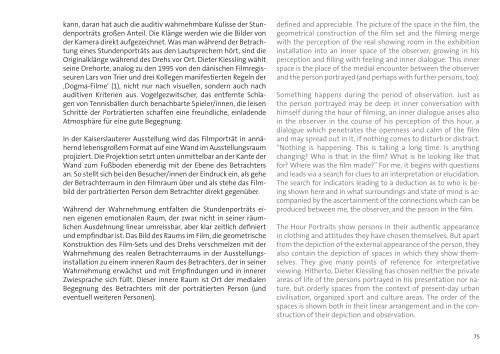DIETER KIESSLING - home
DIETER KIESSLING - home
DIETER KIESSLING - home
Erfolgreiche ePaper selbst erstellen
Machen Sie aus Ihren PDF Publikationen ein blätterbares Flipbook mit unserer einzigartigen Google optimierten e-Paper Software.
kann, daran hat auch die auditiv wahrnehmbare Kulisse der Stundenporträts<br />
großen Anteil. Die Klänge werden wie die Bilder von<br />
der Kamera direkt aufgezeichnet. Was man während der Betrachtung<br />
eines Stundenporträts aus den Lautsprechern hört, sind die<br />
Originalklänge während des Drehs vor Ort. Dieter Kiessling wählt<br />
seine Drehorte, analog zu den 1995 von den dänischen Filmregisseuren<br />
Lars von Trier und drei Kollegen manifestierten Regeln der<br />
‚Dogma-Filme‘ (1), nicht nur nach visuellen, sondern auch nach<br />
auditiven Kriterien aus. Vogelgezwitscher, das entfernte Schlagen<br />
von Tennisbällen durch benachbarte Spieler/innen, die leisen<br />
Schritte der Porträtierten schaffen eine freundliche, einladende<br />
Atmosphäre für eine gute Begegnung.<br />
In der Kaiserslauterer Ausstellung wird das Filmporträt in annähernd<br />
lebensgroßem Format auf eine Wand im Ausstellungsraum<br />
projiziert. Die Projektion setzt unten unmittelbar an der Kante der<br />
Wand zum Fußboden ebenerdig mit der Ebene des Betrachters<br />
an. So stellt sich bei den Besucher/innen der Eindruck ein, als gehe<br />
der Betrachterraum in den Filmraum über und als stehe das Filmbild<br />
der porträtierten Person dem Betrachter direkt gegenüber.<br />
Während der Wahrnehmung entfalten die Stundenporträts einen<br />
eigenen emotionalen Raum, der zwar nicht in seiner räumlichen<br />
Ausdehnung linear umreissbar, aber klar zeitlich definiert<br />
und empfindbar ist. Das Bild des Raums im Film, die geometrische<br />
Konstruktion des Film-Sets und des Drehs verschmelzen mit der<br />
Wahrnehmung des realen Betrachterraums in der Ausstellungsinstallation<br />
zu einem inneren Raum des Betrachters, der in seiner<br />
Wahrnehmung erwächst und mit Empfindungen und in innerer<br />
Zwiesprache sich füllt. Dieser innere Raum ist Ort der medialen<br />
Begegnung des Betrachters mit der porträtierten Person (und<br />
eventuell weiteren Personen).<br />
defined and appreciable. The picture of the space in the film, the<br />
geometrical construction of the film set and the filming merge<br />
with the perception of the real showing room in the exhibition<br />
installation into an inner space of the observer, growing in his<br />
perception and filling with feeling and inner dialogue. This inner<br />
space is the place of the medial encounter between the observer<br />
and the person portrayed (and perhaps with further persons, too).<br />
Something happens during the period of observation. Just as<br />
the person portrayed may be deep in inner conversation with<br />
himself during the hour of filming, an inner dialogue arises also<br />
in the observer in the course of his perception of this hour, a<br />
dialogue which penetrates the openness and calm of the film<br />
and may spread out in it, if nothing comes to disturb or distract.<br />
“Nothing is happening. This is taking a long time. Is anything<br />
changing? Who is that in the film? What is he looking like that<br />
for? Where was the film made?” For me, it begins with questions<br />
and leads via a search for clues to an interpretation or elucidation.<br />
The search for indicators leading to a deduction as to who is being<br />
shown here and in what surroundings and state of mind is accompanied<br />
by the ascertainment of the connections which can be<br />
produced between me, the observer, and the person in the film.<br />
The Hour Portraits show persons in their authentic appearance<br />
in clothing and attitudes they have chosen themselves. But apart<br />
from the depiction of the external appearance of the person, they<br />
also contain the depiction of spaces in which they show themselves.<br />
They give many points of reference for interpretative<br />
viewing. Hitherto, Dieter Kiessling has chosen neither the private<br />
areas of life of the persons portrayed in his presentation nor nature,<br />
but orderly spaces from the context of present-day urban<br />
civilisation, organized sport and culture areas. The order of the<br />
spaces is shown both in their linear arrangement and in the construction<br />
of their depiction and observation.<br />
75


